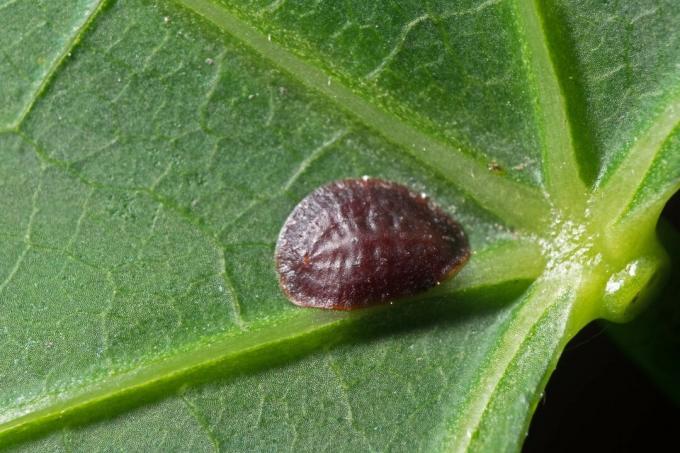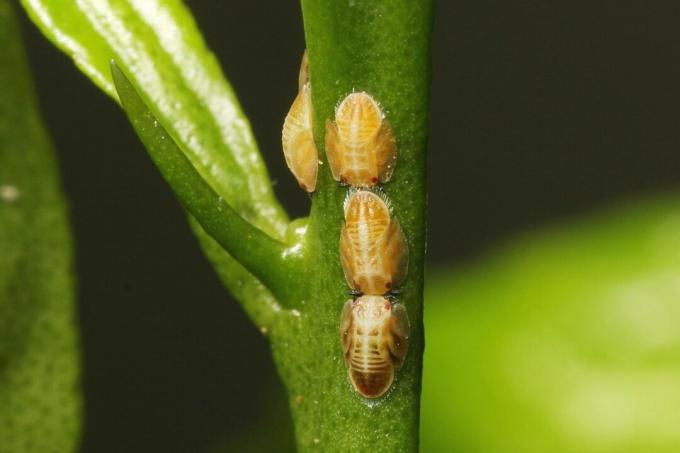Fight scale insects quickly and effectively: We will show you how to get rid of unpleasant lice quickly using biological and chemical means.
Scale insects, like other plant lice, are equipped with a proboscis. With this they suck up the high-energy plant sap and thus weaken the infected plant. For this reason, scale insects are pests and they are a major problem, especially on indoor plants. Successful combat also requires a consistent approach to eliminate the annoying beasts. But did you also know that high-quality raw materials are made from scale insects? In the past, certain species were primarily used as suppliers of the red pigment carmine. This used to give many lipsticks and foods a strong red color. Even the red Campari was colored with carmine some time ago.
contents
- Recognize scale insects
- Scale insects: a fact sheet
- Prevent scale insects
-
Fight scale insects
- Fight scale insects biologically
- Fight scale insects chemically
- Fight scale insects with beneficial insects
Recognize scale insects
The scale insect family (Coccoidea) is relatively species-rich. Around 100 types of plant teat are represented in Central Europe. This biodiversity ensures that scale insects differ considerably from one another. In our opinion, it is therefore important to recognize the general signs of a scale insect infestation and not to get entangled in the visual details of the various scale insects. Although scale insects also attack woody plants and grapevines, the real problem for the hobby gardener is usually the infested house plants. The scale insects particularly like to choose orchids, palms, ficus, citrus trees and oleanders as host plants.

A strong infestation usually occurs in winter and spring, when the plants are weakened by poor site conditions. Then the 0.8 to 6 mm scale insects multiply extremely quickly and become a problem for the affected plant. They like to hide at the roots of the leaves, the underside of the leaves and other hard-to-reach places on the plant, which makes it even more difficult to find them. Honeydew is a sure sign of a scale insect infestation. Just like aphids, female scale insects also produce sugar-rich honeydew, which quickly sticks entire leaves together. In connection with the immobile scale insects and the characteristic back shield, this is a sure sign of a scale insect infestation. The scale insects often appear in a colony-like manner, which is why many pustule-like structures concentrated in one place on the plant also speak for scale insects.
Scale insects: a fact sheet
Scale insects are very variable in their nature, depending on the stage of development and gender. In principle, we only see the older females of the scale insect as pests. The females have a pronounced shield for protection in their later development. This protective shield is also necessary because the female louse is completely immobile from its second larval stage and thus cannot escape predators. At this point, the females are busy ingesting the sap through the proboscis, laying eggs and releasing honeydew. The females can lay fertile eggs without fertilizing a male. This so-called virgin generation is responsible for the rapid multiplication of the scale insects.

The eggs of the scale insects are often protected near or directly under the mother animal. The 0.8 mm young larvae hatch from them. These larvae are still mobile and can therefore find a new place on the plant to use the sap as food. As early as the second larval stage, the larvae lose their mobility again. The males of the scale insect, however, are always agile and usually winged. Even so, they have a deplorable fate: their sole purpose is to fertilize the females. This is because the males cannot ingest food because the intestines and mouthparts are severely reduced. Because of this, the males only live for a few days.
Prevent scale insects
Since scale insects particularly like to attack indoor plants such as orchids and palm trees, the indoor plants should be checked regularly for the suspicious shields of the scale insects, especially in winter. Often, however, only the large female and immobile scale insects can be recorded during the assessment. The young larvae, which are less than one millimeter in size, are almost undetectable to the human eye. Nevertheless, a close look at newly acquired houseplants cannot do any harm, because scale insects are not so easy to control. Because the male scale insects can fly, one might conclude that they are also responsible for the spread. Thats not right. The flying skills of the males are very limited and, moreover, they cannot lay eggs and thus cannot reproduce on their own.

In addition to the early detection of a tortoiseshell population, the condition of the plant is crucial. The scale insects often reproduce rampantly on their host plants because they are weakened due to the location. The most common cause is the lack of light intensity in winter and also in spring. The lack of light in connection with dry and often too warm air is pure stress for most potted and houseplants. Excessive nitrogen fertilization has just as bad effects on the vitality of plants. These factors lead to a very susceptible plant that can hardly defend itself against a scale insect infestation. Remedial action can only be created to a limited extent. In any case, nitrogen fertilization should be greatly reduced or suspended in winter. If your indoor plants get too little light in winter, the plants should also be kept as cool as possible. The plant can only adapt its metabolism to the poor light conditions at cooler temperatures. In addition, the scale insect also develops more slowly at low temperatures.
Attention: Of course, the plant may only be kept as cold as it can handle!
Fight scale insects
In most cases, an infestation by scale insects is only recognized when they have already reproduced quite well. At this point in time, it is usually no longer useful to collect the scale insects. In addition, animals can remain undetected in hidden places, as can the small young larvae. The scale insects would reproduce quickly again and the problem would not be eliminated.
We recommend the following products:
- Neudorff Promanal shield and mealybug free: ready-to-use spray for the control of mealybugs, scale insects and spider mites on ornamental plants. The oily spray coating lets the pests suffocate and gives the leaves a beautiful sheen. Not dangerous for bees.
- Bayer ornamental plant spray Lizetan AF: Versatile spray that is also effective against hidden pests. Very compatible with plants, including orchids.
- Order set beneficial insects: Tick the desired beneficial insect on the order form, send it in and receive it conveniently by post.
Fight scale insects biologically
Unfortunately, it is only possible to control scale insects with pesticides. The biological agent of choice is an oil supplement. Biological agents such as neem or pyrethrum have a very bad effect as contact poison, as the scale insects are well protected against these active substances by their shell. Oil preparations (e.g. based on rapeseed oil), on the other hand, fight scale insects very effectively. The oil covers the lice with a thin film and suffocates them. Means of this kind are completely harmless for us humans, but the treated plants can react very sensitively to oil products. Before you wet the whole plant with the oil agent so that the scale insect is controlled, the preparation should be tried on a small section of the leaf. Only when there is no damage to the leaves can you control the scale insects all over the plant. But also bear in mind that the treated plants will be very sensitive to light over the next few days. Avoid direct sunlight on the treated plants in any case.

Fight scale insects chemically
If the oil preparation does not get along with your affected plant, usually only throwing away the affected plant or conventional plant protection products will help. If you use chemical products to control scale insects, we recommend Lizetan from Bayer. The agent can be poured or sprayed, which means that the active ingredient is absorbed by the plants. Due to the sucking activity of the scale insects, the poison is also absorbed by the pests and the scale insects are thus combated very effectively. The active ingredient remains in the plant for a few days, which is why young scale insects are also combated that have not yet sucked on the plant during the plant protection measure. Lizetan is also available in the form of sticks that are simply stuck into the ground. The best and safest control method, however, is to spray the liquid crop protection agent over the entire plant.

Fight scale insects with beneficial insects
The use of beneficial insects is usually only something for real insect connoisseurs. Because beneficial insects are highly specific and only attack individual scale insects, beneficial insects cannot be used across the board against all scale insects. Here, the identification of the exact type of scale insect would be the basis for effective control. If you absolutely want to use beneficial insects to control scale insects, then a specialist should determine the type of scale insect beforehand. Often this service is offered by the distributor of the beneficial insects. For the control of scale insects, different parasitic wasp species come into question.
Another species of aphid that many gardeners struggle with is the aphid. Find out everything about appearance, origin and different types of in our profile Aphids.
Special thanks to the photographers: Gilles San Martin, Scot Nelson, USGS Bee Inventory and Monitoring Lab, Bob Peterson, Pavel Kirillov, jacinta lluch Valero, Maja Dumat - Creative Commons License BY 2.0 and Gailhampshire.
